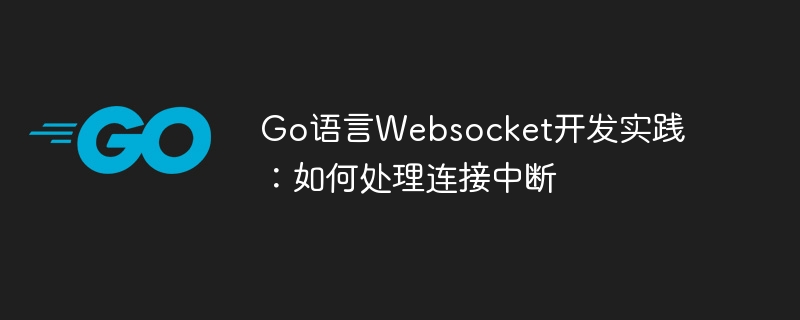Home >Backend Development >Golang >Go language Websocket development practice: how to handle connection interruptions
Go language Websocket development practice: how to handle connection interruptions
- WBOYWBOYWBOYWBOYWBOYWBOYWBOYWBOYWBOYWBOYWBOYWBOYWBOriginal
- 2023-12-14 13:42:311508browse

Go language Websocket development practice: how to handle connection interruptions
Introduction:
Websocket is a protocol for two-way communication between a web browser and a server , real-time interaction and data transmission can be achieved through this protocol. In the Go language, you can easily use the github.com/gorilla/websocket package provided in the standard library for Websocket development. However, in practical applications, connection interruption is a common problem, and how to correctly handle connection interruption is very important for developers. This article will use specific code examples to explain how to handle connection interruptions in the Go language.
1. Establishing a Websocket connection
Before explaining how to handle connection interruptions, let’s briefly introduce how to establish a Websocket connection. In Go language, you can use the github.com/gorilla/websocket package to implement Websocket connection.
package main
import (
"log"
"net/http"
"github.com/gorilla/websocket"
)
var upgrader = websocket.Upgrader{
ReadBufferSize: 1024,
WriteBufferSize: 1024,
}
func echo(w http.ResponseWriter, r *http.Request) {
conn, err := upgrader.Upgrade(w, r, nil)
if err != nil {
log.Println(err)
return
}
defer conn.Close()
for {
// 读取消息
messageType, p, err := conn.ReadMessage()
if err != nil {
log.Println(err)
break
}
// 处理消息
err = conn.WriteMessage(messageType, p)
if err != nil {
log.Println(err)
break
}
}
}
func main() {
http.HandleFunc("/echo", echo)
log.Fatal(http.ListenAndServe(":8080", nil))
}Code explanation:
-
upgraderdefines the parameter configuration for Upgrade HTTP request for WebSocket connection. -
echoThe function handles the logic of the WebSocket connection. In this function, the message can be read and processed.
2. Handling connection interruption
Connection interruption means that the connection between the client and the server is interrupted for some reason, resulting in the inability to perform normal data transmission. In Websocket development, we need to handle connection interruptions reasonably.
In the above code example, we have defined an echo function to handle Websocket connections. In this function, we need to add processing logic for connection interruption.
First, we need to add a select statement to monitor the connection status before reading the message in the for loop.
func echo(w http.ResponseWriter, r *http.Request) {
conn, err := upgrader.Upgrade(w, r, nil)
if err != nil {
log.Println(err)
return
}
defer conn.Close()
for {
select {
case <-stopCh:
// 处理连接中断
log.Println("connection interrupted")
return
default:
// 读取消息
messageType, p, err := conn.ReadMessage()
if err != nil {
log.Println(err)
break
}
// 处理消息
err = conn.WriteMessage(messageType, p)
if err != nil {
log.Println(err)
break
}
}
}
}In the above code, we use a stopCh channel to indicate the signal of connection interruption. When we need to interrupt the connection, we only need to send a signal to the stopCh channel.
Then, we need to send a signal that the connection is interrupted when the connection is closed elsewhere. For example, we can close the connection according to specific business logic in the processing function of http.HandleFunc.
func main() {
http.HandleFunc("/echo", func(w http.ResponseWriter, r *http.Request) {
// 具体的业务逻辑处理
// 中断连接
stopCh <- struct{}{}
})
log.Fatal(http.ListenAndServe(":8080", nil))
}With the above code example, we can correctly handle connection interruptions. When the connection is interrupted, the corresponding log information will be printed out and the loop will exit, thereby terminating the connection.
Conclusion:
In Go language Websocket development, connection interruption is a problem that needs attention. By handling connection interruptions appropriately, the robustness and reliability of Websocket applications can be improved. In this article, we introduce how to handle the connection interruption problem in Go language through specific code examples. We hope it will be helpful to readers.
The above is the detailed content of Go language Websocket development practice: how to handle connection interruptions. For more information, please follow other related articles on the PHP Chinese website!

